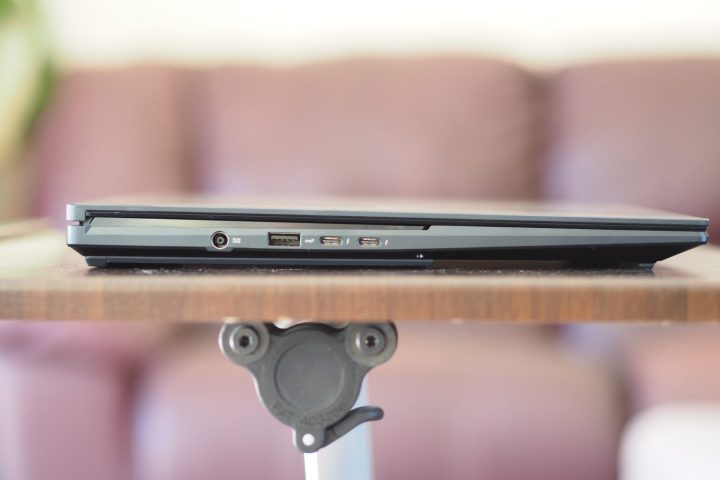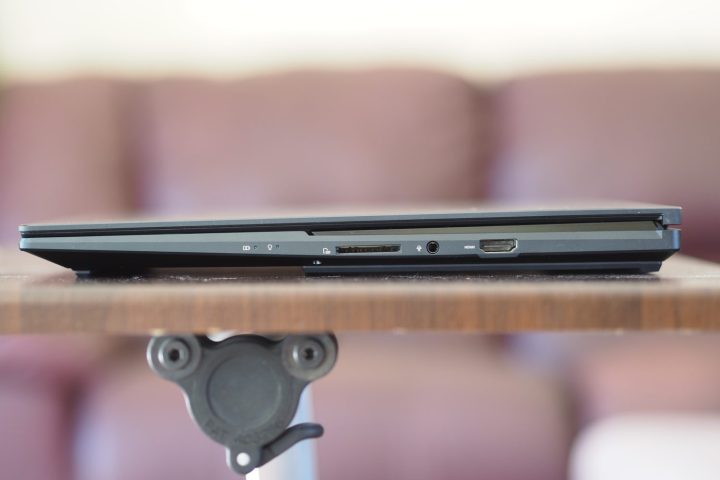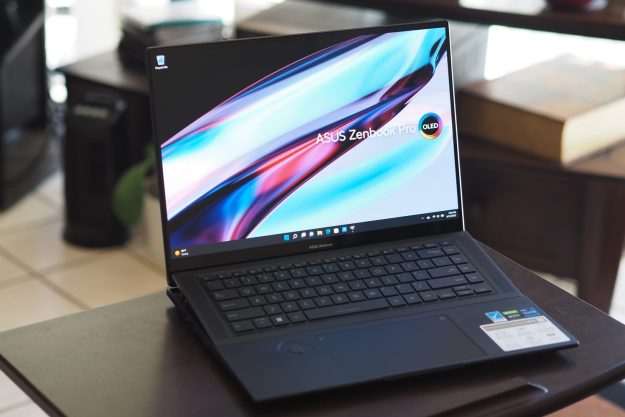
- Simple good looks
- Excellent productivity and creative performance
- Spectacular OLED display
- Great keyboard and haptic touchpad
- Asus Dial is actually useful
- Solid build quality
- Inconsistent gaming performance
- Somewhat expensive
Asus isn’t afraid to try new things with its laptop designs. The ZenBook Pro 16X is proof of that claim, as it features a keyboard that rises up at a steep angle when you open the lid and RGB lights underneath each side that flash on various system activities. Then there’s the Asus Dial, a rotary touch device allowing refined control over the system and supported applications.
Like the ZenBook Pro 14 Duo‘s dual OLED displays, the ZenBook Pro 16X is full of interesting features, and it’s also configured fairly well for creative app performance.
Fortunately, this one doesn’t have to live and die on the success of its gimmicks, because the laptop’s performance is as solid as its build quality — it’s far more than just smoke and mirrors.
Price and configurations
There are two configurations of the ZenBook Pro 16X. My $2,600 review unit was configured with an Intel Core i7-12700H, 16GB of LPDDR5 RAM, a 1TB PCIe 4 SSD, an Nvidia GeForce RTX 3060 GPU, and a UHD+ (3,840 x 2,400) OLED display. The high-end configuration is $3,000 for a Core i9-12900H, 32GB of RAM, a 1TB SSD, the RTX 3060, and the same OLED display. That’s expensive, but not egregiously given the components and design.
The MSI Creator Z16P, for example, is a much more expensive laptop, starting at $2,900 for the same CPU,
Design

The ZenBook Pro 16X doesn’t cut much of an exciting figure when it’s closed. It has the new Star Trek-like Asus logo on the lid, which glows along with the rest of the lighting system, and a faint example of the iconic Asus concentric swirl. Otherwise, its black chassis has straightforward lines and is quite minimalistic. You can tell it’s different by the extra mechanism apparent from the side, which looks a little strange.
But open it up,and things get interesting. The keyboard rises up with the display to a full seven degrees, creating an angled typing surface and 30% increased airflow. The Asus Dial to the left of the large touchpad catches your attention immediately, giving the keyboard deck a high-tech look. And the keyboard lighting is augmented by side RGB lightbars that illuminate the edges of the chassis immediately underneath the keyboard. There’s no other laptop quite like it, although the ZenBook Pro 14 Duo presents a similar simple aesthetic when closed and an intricate appearance when open.

Speaking of the lighting, both the keyboard and lightbar can be configured to flash different colors based on various system events. For example, when you use the MyAsusapp to change the thermal settings, the lights flash different colors in time with your mouse clicks. The lights can respond to a USB device being plugged in, the laptop entering battery-saving mode, and switching between foreground apps.
According to Asus, you can set custom ambient lighting modes, but I couldn’t find the settings to do so. Also, Asus describes the keyboard as having per-key White RGB backlighting, but it supports various colors. Of all the unusual features, the lighting system is the least useful, although it’s a whimsical touch for those who like such things.
The ZenBook Pro 16X is a large laptop, with a 16:10 16-inch display that makes it quite tall. Even so, its small display bezels keep the chassis size to a minimum. With its 16:10 15.6-inch display, it’s more significant than the Dell XPS 15 by about half an inch in width and almost a full inch in depth. The ZenBook is thinner, though, at 0.67 inches versus 0.73 inches, and it’s quite a bit heavier at 5.29 pounds versus 4.62 pounds. The ZenBook is almost identically sized to the MSI Creator Z16P in width, depth, and weight, while the MSI is thicker at 0.74 inches. No matter how you cut it, the ZenBook Pro 16X is a large, heavy laptop that’s not meant to be terribly portable.
It’s constructed of CNC machined aluminum and despite the complexity, Asus managed to build a rock-solid laptop. The lid, keyboard deck, and chassis bottom all resist flexing, bending, or twisting. The ZenBook Pro 16X feels as solid as a MacBook Pro, which puts it in excellent company. It’s even more solid than other excellent
Ports and connections
Connectivity is more than sufficient. There are two USB-C ports with Thunderbolt 4 support, a USB-A 3.2 Gen 2 port, a full-size
Wi-Fi 6E and Bluetooth 5.2 provide for up-to-date wireless connectivity.
Performance

The ZenBook Pro 16X can be configured with one of two 45-watt Intel 14-core/20-thread 12th-gen CPUs. There’s the Core i7-12700H running at up to 4.7GHz and the Core i9-12900H with a top speed of 5GHz. My review unit equipped the former, which has proven to be a solid performer in our previous reviews.
Asus bundles a utility to control the thermal system to tune for quieter and slower or louder and faster performance. That’s common among manufacturers today, and the Asus utility significantly impacted a couple of our benchmarks. I’ve recorded reports for both balanced and performance modes in the table below. The ZenBook Pro 16X was aggressively tuned, especially in performance mode, hitting 100 degrees Celsius and throttling. Even so, it maintained high frequencies during most of the testing and managed solid performance.
Across all our benchmarks, the ZenBook Pro 16X performed at or above its processor class, especially in performance mode. It fell behind the MSI Creator Z17 on Geekbench 5 and Cinebench R32, especially in single-core mode, but its scores were good overall. It had one of the fastest scores in our Handbrake test that encodes a 420MB video as H.265. I also ran the PCMark 10 Complete benchmark that tests several productivity, multimedia, and creative tasks and it hit 6,621, a fast score for the CPU.
In the Pugetbench Premiere Pro benchmark that runs in a live version of Premiere Pro and uses the GPU to accelerate processes, the ZenBook Pro 16X was average for its class in balanced mode at 771. But it jumped way up to 1,034 in performance mode. That beats
Overall, the performance was excellent. The ZenBook Pro 16X punches a bit above its CPU weight class, competing with faster CPUs and putting in a solid all-around performance. It’s a laptop that can serve the most demanding productivity users and creators looking for a powerful workstation.
| Geekbench (single / multi) |
Handbrake (seconds) |
Cinebench R23 (single / multi) |
Pugetbench Premiere Pro |
|
| Asus ZenBook Pro 16X (Core i7-12700H) |
Bal: 1,628 / 12,227 Perf: 1,629 / 12,526 |
Bal: 78 Perf: 70 |
Bal: 1,655 / 11,983 Perf: 1,657 / 15,621 |
Bal: 771 Perf: 1034 |
| MSI Creator Z16P (Core i9-12900H) |
Bal: 1,769 / 14,034 Perf: 1,835 / 14,051 |
Bal: 71 Perf: 69 |
Bal: 1,844 / 15,047 Perf: 1,837 / 16,084 |
Bal: 717 Perf: 1,042 |
| Dell XPS 17 9720 (Core i7-12700H) |
Bal: 1,712 / 13,176 Perf: 1,747 / 13,239 |
Bal: 74 Perf: 71 |
Bal: 1,778 / 12,696 Perf: 1,779 / 14,086 |
Bal: 771 Perf: 853 |
| Apple MacBook Pro 16 (Apple M1 Pro) |
Bal: 1,773 / 12,605 Perf: N/A |
Bal: 95 Perf: N/A |
Bal: 1,531 / 12,343 Perf: N/A |
Bal: 977 Perf: N/A |
| Razer Blade 17 (Core i7-12800H) |
Bal: 1,808 / 11,843 Perf: N/A |
Bal: 73 Perf: N/A |
Bal: 1,697 / 13,218 Perf: N/A |
Bal: 969 Perf: N/A |
| MSI Creator Z17 (Core i7-12700H) |
Bal: 1,744 / 11,750 Perf: 1,741 / 13,523 |
Bal: 88 Perf: 70 |
Bal: 1,805 / 11,266 Perf: 1,819 / 15,754 |
Bal: 897 Perf: 984 |
| MSI GE76 Raider (Core i9-129000HK) |
Bal: 1,855 / 13,428 Perf: N/A |
Bal: 72 Perf: N/A |
Bal: 1,872 / 16,388 Perf: N/A |
Bal: 1,120 Perf: N/A |
| LG Gram 16 2-in-1 (Core i7-1260P) |
Bal: 1,682 / 9,035 Perf: 1,686 / 9,479 |
Bal: 137 Perf: 113 |
Bal: 1,524 / 6,314 Perf: 1,663 / 8,396 |
N/A |
Gaming
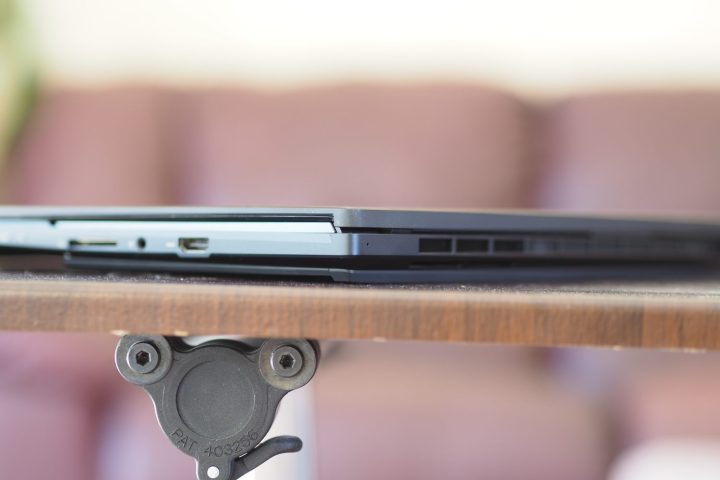
Asus opted for Nvidia’s Studio drivers, which are optimized for reliable and fast scientific, engineering, and creative application performance. That means the company is aiming this laptop at apps like AutoCAD and Adobe’s creative suite rather than games. Even so, with an RTX 3060 installed, one can hope for at least passable gaming performance.
The results from our game benchmark suite were decidedly mixed. The ZenBook Pro 16X performed well in the 3DMark Time Spy test, beating the other two RTX 3060s in the comparison group. But then, it couldn’t run Civilization VI without crashing, something I’ve seen in some other Studio driver-equipped
So, it’s hard to characterize the ZenBook Pro 16X as a gaming laptop. If your game installs and runs without issue, you can get playable frame rates at 1080p with high graphical detail or 1440p if you turn graphics down a bit. But you might have problems with some games, meaning that relying on the laptop as a gaming machine is probably a mistake.
| Assassin’s Creed Valhalla (1080p/1200p Ultra High) |
Cyberpunk 2077 (1080p/1200p Ultra) |
Civilization VI (1080p Ultra) |
Fortnite (1080p/ 1200p Epic) |
3DMark Time Spy |
|
| Asus ZenBook Pro 16X (RTX 3060) |
24 fps | 51 fps | N/A | 65 fps | Bal: 7,047 Perf: 8,221 |
| MSI Creator Z16P (RTX 3080 Ti) |
55 fps | 30 fps | 60 fps | 60 fps | Bal: 9,251 Perf: 10,054 |
| MSI Creator Z16 (RTX 3060) |
50 fps | N/A | 92 fps | 56 fps | Bal: 6,322 Perf: N/A |
| Dell XPS 17 9720 (RTX 3060) |
23 fps | 45 fps | 111 fps | 77 fps | Bal: 6,757 Perf: 6,958 |
| MSI Creator Z17 (RTX 3070 Ti) |
61 fps | N/A | 85 fps | Bal: 8,763 Perf: 9,263 |
|
| Razer Blade 17 (RTX 3080 Ti) |
83 fps | 52 fps | 193 fps | 104 fps | Bal: 12,634 Perf: N/A |
Display and audio

I love a large, bright, colorful OLED display. Turning one on is just a different experience than you get with even the best IPS panels. The ZenBook Pro 16X qualifies as one of the best I’ve experienced in all but one respect.
According to my colorimeter, the display is spectacular in all metrics except its brightness, which while above our 300-nit threshold, isn’t the brightest OLED panel I’ve tested. But the colors are very wide at 100% of sRGB and 98% of AdobeRGB, and the color accuracy is excellent at a Delta-E of 0.84 (anything less than 100% can’t be discerned with the human eye). And the contrast is extremely high, as with all OLED displays, showing off inky blacks.
Note that the contrast difference between the OLED displays and the MacBook Pro 16’s XDR display is due to a change in colorimeters. My SpyderX colorimeter reports lower contrast on these technologies than does the Spyder 4 colorimeter used on the MacBook. Rest assured that when tested with the same colorimeter, these displays achieve similar contrast results and are equally impressive.
Asus includes a utility that works hand in hand with a colorimeter (right now, just the X-Rite i1 Display Pro is supported, with more on the way) to provide professional-level calibration. The panel is excellent out of the box, but if colors shift over time, the ProArt Creator Hub utility can be used to bring things back in order.
The ZenBook Pro 16X display perfectly matches the laptop’s performance, providing an experience that creators will love, as will productivity users and content consumers. The only display that’s more colorful is the Dell XPS 17’s IPS display, and it doesn’t have OLED’s deep blacks. There’s just a lot to love here.
| Brightness (nits) |
Contrast | sRGB gamut | AdobeRGB gamut | Accuracy DeltaE (lower is better) |
|
| Asus ZenBook Pro 16X (OLED) |
365 | 26,090:1 | 100% | 98% | 0.84 |
| MSI Creator Z16P (IPS) |
461 | 990:1 | 100% | 89% | 0.89 |
| Dell XPS 17 9720 (IPS) |
543 | 1,870:1 | 100% | 100% | 0.58 |
| Dell XPS 15 9520 (OLED) |
391 | 28,130:1 | 100% | 96% | 0.42 |
| Apple MacBook Pro 16 (XDR) |
475 | 475,200:1 | 100% | 90% | 1.04 |
| Razer Blade 17 (IPS) |
313 | 890:1 | 100% | 90% | 0.84 |
Four speakers, two upward-firing and two downward-firing, put out enough volume to completely envelop my home office. Mids and highs are clear and bright, while there’s a touch of bass. The audio system is good enough for bingeing Netflix and listening to music without
Keyboard and touchpad
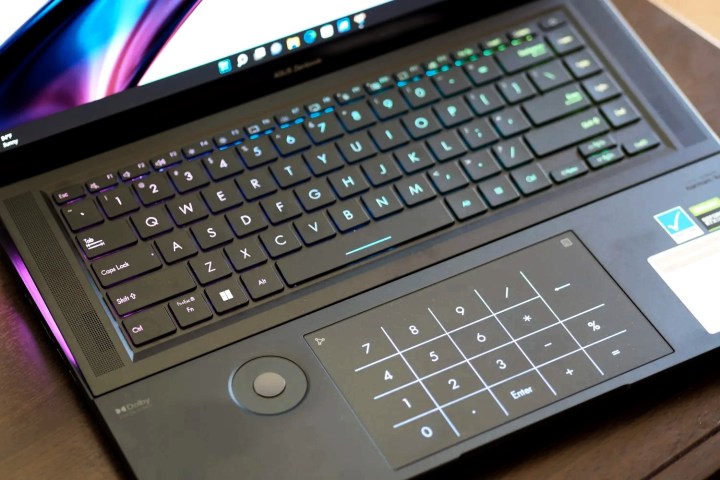
As mentioned previously, the ZenBook Pro 16X’s keyboard is propped up at a seven-degree angle, and it feels like more than that in use. It took me a while to get used to typing because my wrists rested on the flat palm rest and my fingers had to stretch to hit the upper keys. The keycaps are very large, with plenty of spacing, and the switches are light and snappy with a precise bottoming action. It’s a great keyboard once you get used to the angle.
The touchpad is another unusual feature. It’s an expansive haptic touchpad that rivals the MacBook Pro 16’s Force Touch version. I found the touchpad responsive and accurate across its entire surface, and the haptic clicks felt natural. But that’s not all. Asus also included its NumberPad 2.0 technology, which embeds an LED numeric keypad that can be switched on and off. Most users probably won’t find it all that useful, but if you work with a lot of numbers, then you’ll appreciate it. And it saves space on the keyboard by avoiding a physical numeric keypad.

Asus also built in a unique controller, the Asus Dial, which uses a touch-sensitive ring surrounding a physical button to provide rotary control of system utilities and customizable applications. It’s a handy way to control software like Adobe’s Creative Suite, as well as to perform simple tasks like adjusting screen brightness and sound volume. The Asus Dial is a surprisingly useful tool and adds another convenient method for controlling the ZenBook Pro 16X.
Webcam and privacy
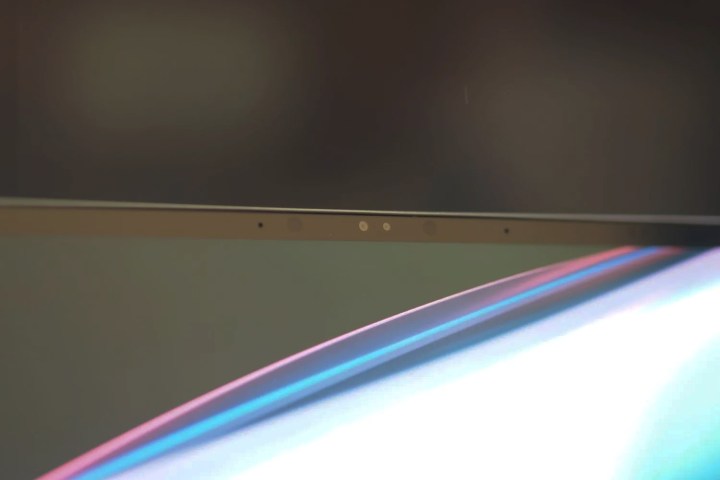
The webcam is a 1080p version with infrared, an RGB color sensor that can adjust the display’s brightness and color temperature based on ambient lighting, and a time of flight sensor. The webcam provides an excellent video image with 3D noise-reduction technology, and it’s bright and detailed in all kinds of lighting conditions. Asus includes its AdaptiveLock technology that can use the Intel Visual Sensing Controller to lock the laptop when the user moves away and wake it up when the user returns. The screen can also dim when the user looks away.
Windows 11 Hello passwordless support is provided by both the infrared camera and a fingerprint reader built into the power button. Both methods worked flawlessly.
Battery life
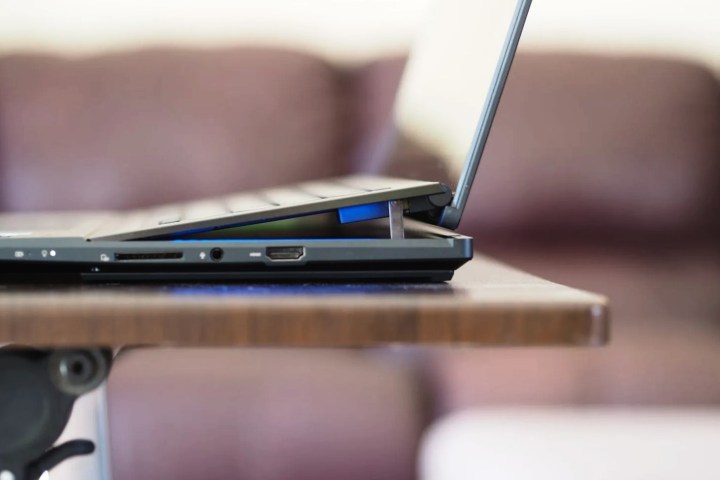
Even 96 watt-hours of battery capacity isn’t a lot when dealing with a 45-watt CPU and a large, high-resolution OLED display. Add in the fact that the ZenBook Pro 16X is tuned for performance, andexpecting excellent battery life would be unreasonable.
As I suspected, the ZenBook Pro 16X didn’t fare well in our suite of battery benchmarks. In our web-browsing test that runs through a series of complex websites, the ZenBook made it to just five hours. It managed just eight hours in our video test that loops a local Full HD Avengers trailer, and 5.5 hours in the PCMark 10 Application battery that’s the best indicator of productivity battery life. Those results align with some of the other creator
Ultimately, you’ll want to take your power brick with you if you need all-day battery life. The ZenBook Pro 16X won’t get you there by itself.
| Web browsing | Video | PCMark 10 Applications |
|
| Asus ZenBook Pro 16X (Core i7-12700H) |
4 hours, 54 minutes | 7 hours, 58 minutes | 5 hours, 28 minutes |
| MSI Creator Z16P (Core i9-12900H) |
4 hours, 42 minutes | 5 hours, 24 minutes | 5 hours, 37 minutes |
| Dell XPS 17 9720 (Core i7-12700H) |
7 hours, 36 minutes | 13 hours, 5 minutes | 7 hours, 3 minutes |
| Dell XPS 15 9520 (Core i7-12700H) |
9 hours, 38 minutes | 12 hours, 40 minutes | 11 hours, 14 minutes |
| MSI Creator Z17 (Core i7-12700H) |
4 hours, 23 minutes | 4 hours, 32 minutes | N/A |
| Apple MacBook Pro 16 (Apple M1 Pro) |
18 hours, 35 minutes | 23 hours, 11 minutes | N/A |
Our take
The Asus ZenBook Pro 16X is a well-designed, well-crafted laptop that meets and exceeds its creator-oriented objectives. It’s surprisingly fast given its components and can be configured to be even faster, its display is spectacular, and its keyboard and touchpad are excellent. It has the useful Asus Dial feature that adds some convenience. All in all, Asus created a standout laptop.
Yes, it’s expensive, but not unexpectedly given the design and components. It’s competitive with other
Are there any alternatives?
The MSI Creator Z16P is a solid competitor for demanding productivity and creative work, and it’s also well-built with a quality display (although nothing nearly as nice as the ZenBook’s). The MSI is also more expensive when fully configured.
If you don’t need quite all that power or the features of the ZenBook, then Dell’s XPS 15 and 17 are good options. They’re also quite fast, and provide the option of going a bit smaller or larger and dialing in performance accordingly.
Finally, Apple’s MacBook Pro 16 is a natural competitor, offering just as high quality a build, excellent performance, and a top-notch display while also offering unbelievable battery life. It’s considerably more expensive, though.
How long will it last?
The ZenBook Pro 16X is rock solid, and even though it has some complex mechanisms, it feels like it should last for years of service. The components are up to date as well. Only the industry-standard one-year warranty is disappointing.
Should you buy it?
Yes, if you do creative work or have a seriously demanding productivity workflow, the ZenBook Pro 16X will meet your needs and then some.

